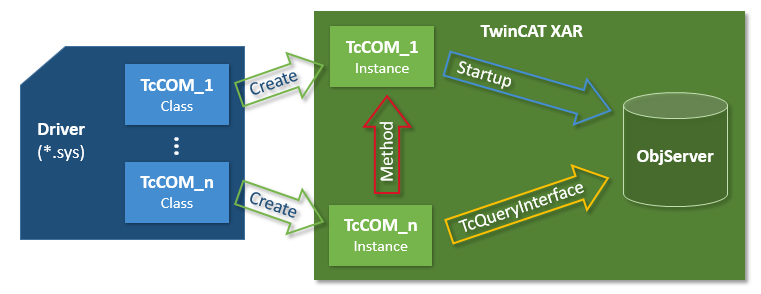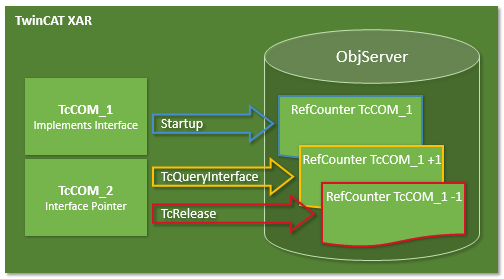The TwinCAT Component Object Model (TcCOM) concept
The TwinCAT Component Object Model defines the characteristics and the behavior of the modules. The model derived from the "Component Object Model" COM from Microsoft Windows describes the way in which various independently developed and compiled software components can co-operate with one another. To make that possible, a precisely defined mode of behavior and the observation of interfaces of the module must be defined, so that they can interact. Such an interface is also ideal for facilitating interaction between modules from different manufacturers, for example.
To some degree TcCOM is based on COM (Component Object Model of the Microsoft Windows world), although only a subset of COM is used. In comparison with COM, however, TcCOM contains additional definitions that go beyond COM, for example the state machine module.
Overview and application of TcCOM modules
This introductory overview is intended to make the individual topics easier to understand.
One or several TcCOM modules are consolidated in a driver. This driver is created by TwinCAT Engineering using the MSVC compiler. The modules and interfaces are described in a TMC (TwinCAT Module Class) file. The drivers and their TMC file can now be exchanged and combined between the engineering systems.

Instances of these modules are now created using the engineering facility. They are associated with a TMI file. The instances can be parameterized and linked with each other and with other modules to form the I/O. A corresponding configuration is transferred to the target system, where it is executed.
Corresponding modules are started, which register with the TwinCAT ObjectServer. The TwinCAT XAR also provides the process images. Modules can query the TwinCAT ObjectServer for a reference to another object with regard to a particular interface. If such a reference is available, the interface methods can be called on the module instance.
The following sections substantiate the individual topics.
ID Management
Different types of ID are used for the interaction of the modules with each other and also within the modules. TcCOM uses GUIDs (128-bit) and 32-bit long integers.
TcCOM uses
- GUIDs for: ModulIDs, ClassIDs and InterfaceIDs.
- 32-bit long integers are used for: ParameterIDs, ObjectIDs, ContextIDs, CategoryID.
Interfaces
An important component of COM, and therefore of TcCOM too, are interfaces.
Interfaces define a set of methods that are combined to perform a certain task. An interface is referenced with a unique ID (InterfaceID), which must never be modified as long as the interface does not change. This ID enables modules to determine whether they can cooperate with other modules. At the same time the development process can take place independently, if the interfaces are clearly defined. Modifications of interfaces therefore lead to different IDs. The TcCOM concept is designed such that InterfaceIDs can superpose other (older) InterfaceIDs ( "Hides" in the TMC description / TMC editor). In this way, both versions of the interface are available, while on the other hand it is always clear which is the latest InterfaceID. The same concept also exists for the data types.
TcCOM itself already defines a whole series of interfaces that are prescribed in some cases (e.g. ITComObject), but are optional in most. Many interfaces only make sense in certain application areas. Other interfaces are so general that they can often be re-used. Provision is made for customer-defined interfaces, so that two third-party modules can interact with each other, for example.
- All interfaces are derived from the basic interface ItcUnknown which, like the corresponding interface of COM, provides the basic services for querying other interfaces of the module (TcQueryInterface) and for controlling the service life of the module (TcAddRef and TcRelease).
- The ITComObject interface, which must be implemented by each module, contains methods for accessing the name, ObjectID, ObjectID of the parent, parameters and state machine of the module.
Several general interfaces are used by many modules:
- ITcCyclic is implemented by modules, which are called cyclically ("CycleUpdate"). The module can register via the ITcCyclicCaller interface of a TwinCAT task to obtain cyclic calls.
- The ITcADI interface can be used to access data areas of a module.
- ITcWatchSource is implemented by default; it facilitates ADS DeviceNotifications and other features.
- The ITcTask interface, which is implemented by the tasks of the real-time system, provides information about the cycle time, the priority and other task information.
- The ITComObjectServer interface is implemented by the ObjectServer and referenced by all modules.
A whole series of general interfaces has already been defined. General interfaces have the advantage that their use supports the exchange and recycling of modules. Only if no suitable general interfaces exist should you define your own interfaces.
Class Factories
"Class Factories" are used for creating modules in C++. All modules contained in a driver have a common Class Factory. The Class Factory registers once with the ObjectServer and offers its services for the creation of certain module classes. The module classes are identified by the unique ClassID of the module. When the ObjectServer requests a new module (based on the initialization data of the configurator or through other modules at runtime), the module selects the right Class Factory based on the ClassID and triggers creation of the module via its ITcClassFactory interface.
Module service life
Similar to COM, the service life of a module is determined via a reference counter (RefCounter). The reference counter is incremented whenever a module interface is queried. The counter is decremented when the interface is released. An interface is also queried when a module logs into the ObjectServer (the ITComObject interface), so that the reference counter is at least 1. The counter is decremented on logout. When the counter reaches 0, the module deletes itself automatically, usually after logout from the ObjectServer. If another module already maintains a reference (has an interface pointer), the module continues to exist, and the interface pointer remains valid, until this pointer is released.
